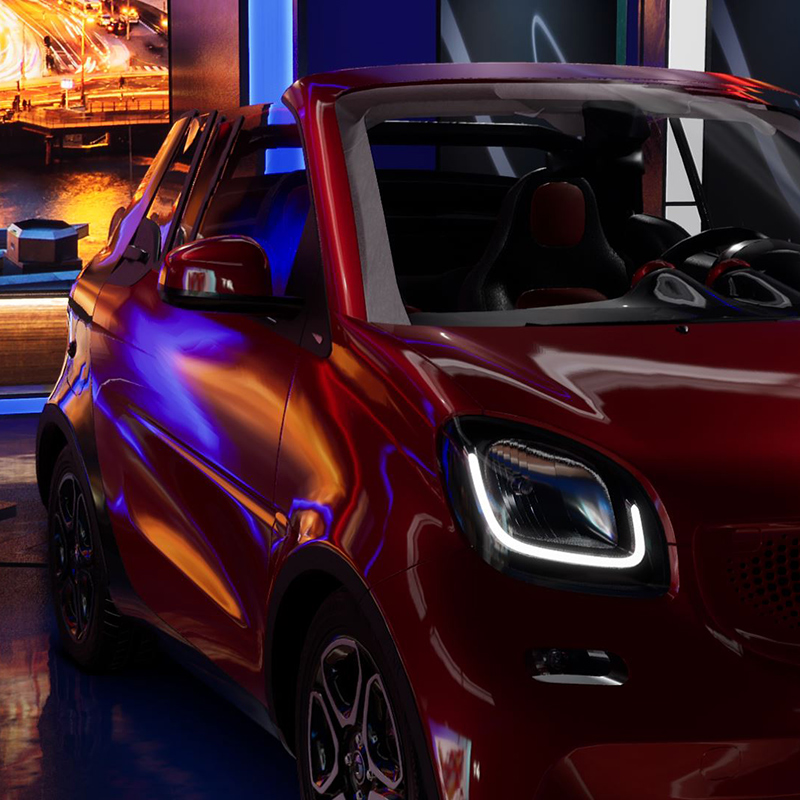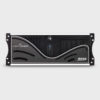Opis
Voyager uses the UX control platform as an operator-friendly front end, so operators are not required to know the Unreal 4 engine to use the system. Voyager supports customization, flexibility, and scalability in terms of number of cameras and graphics engines through the integration of UX and UX VCC applications.
Cutting-edge technology
Voyager uses the Unreal gaming engine by Epic games, the leading gaming engine in the industry with thousands of developers worldwide.
Superior graphics capabilities
The Unreal4 gaming engine utilizes advanced graphics features like particles, dynamic texture, real-time reflections and Shadows, skeleton animation, and cloth animation. As a result of its extensive graphics feature set, designers can achieve realistic looks with greater accuracy and ease than ever before.
Ease of operation
Voyager uses UX control platform as its operator friendly front end and doesn’t require the operator to be an experienced Unreal4 user or designer.
Flexible workflow
With UX and UX VCC, any combination of tracking protocols, camera mounts, and engines is achievable within the same environment
Workflow and Connectivity
Through UX, Voyager supports external data connectivity, seamless integration with MOS based newsroom systems and enables triggering from studio automation systems.
Real-Time Reactiveness
Voyager enables real time control over scene elements, in PIE mode, without the need to package the project to go on-air.
Features

Real-Time Dynamic Shaders
Unreal4 allows the use of shaders to create realistic looking effects. From dynamic shadows, live-lights and light blooms, to reflections and refractions. These shaders and effects are applicable both in Augmented Reality and Virtual Studio environment.

Complex Animations
Unreal4 offers an unparalleled level of animation capabilities – IK, Skeleton, cloth, and Particles are just a part of the toolset. Voyager supports the use of Unreal’s sequencer to manage complex animations and trigger them effortlessly.
Tracking
Through the use of UX, it is possible to mix and match tracking protocols and camera mounts to meet the requirements of the production. Weather its manual heads, mechanical encoders, cable cams, or optical tracking system, it is all transparent to UX.

Newsroom Integration
Through UX, Voyager supports seamless integration with MOS based newsroom systems. By using the UX Events as templates, journalists can easily select an event, populate it, and add it to their stories. UX can then be used in conjunction with Overdrive for a fully automated production. Voyager supports ActiveX and HTML5 MOS plugins.

Data Integration
Driving graphics with external data into the Unreal Engine is straightforward with UX & Voyager’s external data capabilities. Voyager is linked to XPression Datalinq server, to parse data from multiple external data sources and feed it directly into Voyager. Tell better stories, discuss statistics, or show the forecast, it is all at your fingertips.

Logic & Scripting
The Blueprint Visual Scripting system in the Unreal Engine is a complete and highly versatile scripting system, based on the concept of using a node-based interface to create interactions from within the Unreal Editor. UX offers control and triggering ability over blueprints, by hooking into the UE4 workflow.

Unreal 4.25
Voyager 4 is built on Unreal Engine version 4.25. as part of this build, Voyager users can make use of the 3D text capability, improvements to Datasmith workflow, Variant manager, and color difference tools.

PANASONIC AW-UE 150 INTEGRATION
Voyager 4 works seamlessly with the Panasonic AW-UE150 PTZ camera. Select the camera from UX mounts list, select the right lens curve, and you are ready to produce content. From UX native interface, you can even open Panasonic’s web interface to control multiple cameras, and see a preview of each camera.

NDI
Voyager 4 support ND I ® streams as sources, and thus saves on hardware resources of the system.
Applications
This product can be used as part of the following
Smart Production Solutions:
- Sports & Live Venue
- Government
- News
- Corporate
- Virtual Studio
- House of Worship
- Mobile
- Education
Monogram Creative Console Integration
Monogram Creative Console is a modular, free-form control surface designed to enable hands-on and dynamic interaction with creative software.
About Monogram Creative Console
Each console is a system of magnetically-connected modules.
- Core: connects and powers the entire layout. Includes IPS LCD that displays the active profile and 2 mechanical keys for switching profiles
- Key: 3 tactile, mechanical keyswitches
- Dial: 3 infinite-turn encoders with secondary press function
- Slider: 3 60mm linear faders
- Orbiter: 3 dimensions of control. Uses a pressure-sensitive center disc (X/Y axes) surrounded by an infinite-turn encoder ring (Z axis)
Profiles & Integrations
- Monogram Creator software runs in the background and connects the console to integrations like UX
- Consists of a UI for module assignments and a service that drives integrations
- Creator manages the modular layout—modules keep their function when moved around.
- Assign modules to control UX; change their sensitivity, range, and incrementation in Creator
- These sets of assignments are called Profiles; profiles can be saved, recalled, and shared amongst crew
Key Benefits for Operators
- Direct access to objects in the scene. Gives the operator the ability to move, rotate, scale, and animate without distraction from menus or tool panels.
- Muscle memory and enhanced precision. Offers an immediacy and precision that is impossible to replicate using an on-screen UI.
- Control multiple parameters simultaneously.
Visit Monogram CC’s web store to find a unique UX dedicated package.
Specification
Voyager hardware is designed to guaranty the highest level of resilience and stability using the best available components.
| HARDWARE | |
|---|---|
| Mainboard | ASUS WS X299 SAGE/10G |
| CPU | Intel® CoreTM i7-9800x Processor 16.5MB Cache, LGA2066 |
| Memory | 32 GB DDR4 |
| GPU | NVIDIA RTX 2080 Ti, 11G-P4-2280-KR, 11GB GDDR6 |
| Output Board | Matrox DSXLE4/8/100F I/O Card Matrox X.mio3 12G SDI I/O Card |
| RAID Controller | LSI® MegaRAID® SAS 9361-8i |
| Storage Media | 3 x 1TB SSD RAID 5 |
| System Drives | 2 x 256GB SSD RAID 1 (Mirrored) |
| Media Drive | 1.8TB |
| Network | Dual RJ-45, 10 Gigabit Ethernet Ports |
| Power Supply | 960 W EPS 12V Hot-swappable 1+1 redundant power supply |
| Serial Port | 1 RS-232 Serial Port/Serial GPI |
| GPI | Unlimited RossTalkTM Smart GPI over TCP/IP through UX |
| Genlock | Black Burst, Tri-Level Sync, Lock to Input Source or Free-Running |
| O/S | Windows® 10 Professional, 64-bit |
| DIMENSIONS | |
|---|---|
| Height | 6.9 in (17.6 cm) |
| Width | 16.9 in (43 cm) |
| Depth | 23.3 in (59.2 cm) |
| WEIGHT | |
|---|---|
| Net Weight | 57 lbs (25.9 kg) |
| Net Weight With Rails | 62 lbs (28.1 kg) |
| Gross Weight When Shipped | 83 lbs (37.6 kg) |
| VIDEO FORMATS |
|---|
| 720p 50Hz | 720p 59.94Hz | 720p 60Hz |
| 1080p 25Hz |1080p 29.97Hz | 1080p 30Hz | 1080p 50Hz |
| 1080p 59.94Hz | 1080p 60Hz |
| 1080i 50Hz | 1080i 59.94Hz | 1080i 60Hz |
| UHD 50Hz | UHD 59.94Hz | UHD 60Hz (For 12G card only) |
| CLIP FILE FORMATS | |
|---|---|
| AVI | h.264 |
| MPEG | Mpeg-4 |
| WMV | WMV |
| USB CONNECTIONS | |
|---|---|
| Intel® X299 chipset | 6 x USB 3.1 Gen 1 ports (4 at back panel, 2 at mid-board) |
| ASMedia® USB 3.1 Gen 2 controller | 2 x USB 3.1 Gen 2 ports (2 at back panel) Type-A + USB Type-CTM |
| ASMedia® USB 3.1 Gen 2 controller | 1 x USB 3.1 Gen 2 port (1 at mid-board) |
| INCLUDED ACCESSORIES | |
|---|---|
| Rackmount Kit | Slide rails, handles, and mounting hardware |
| Keyboard | Standard USB PC Keyboard |
| Mouse | USB mouse |
| Security Key | USB license key pre-installed internally |
| Software | Microsoft® Windows® 10 Pro, 64-bit O/S Voyager software package and media |
| Warranty | 12 Month System Warranty (parts, labor and software updates) 5 Years on Hard Disk Drives |








